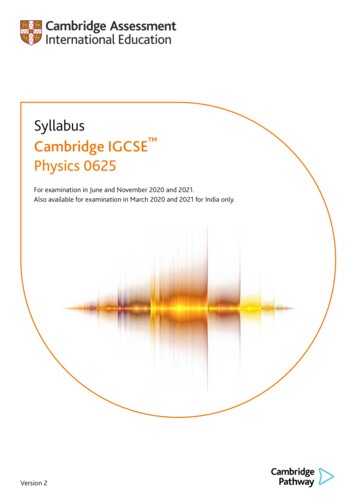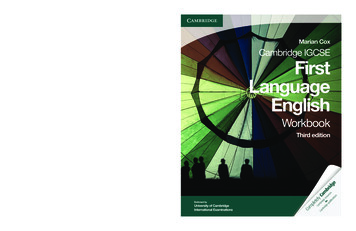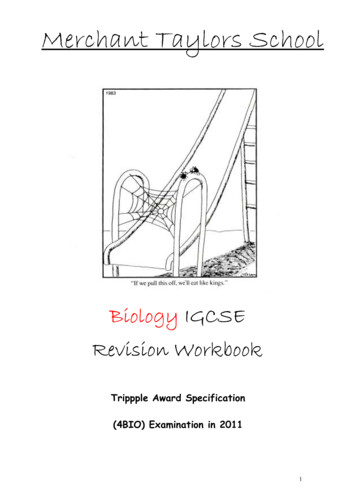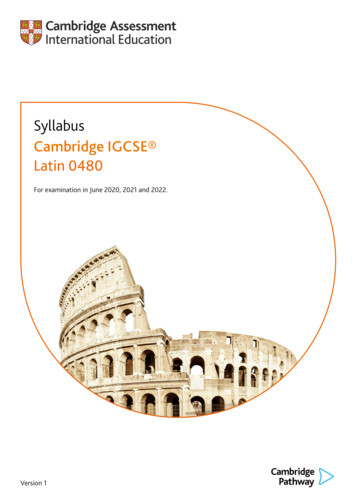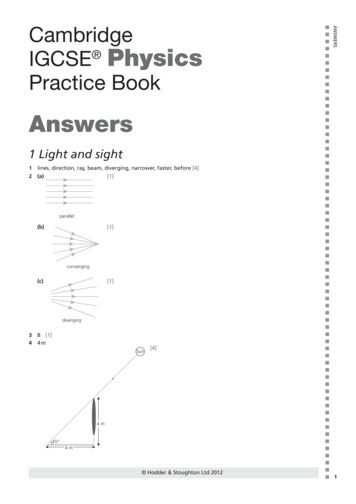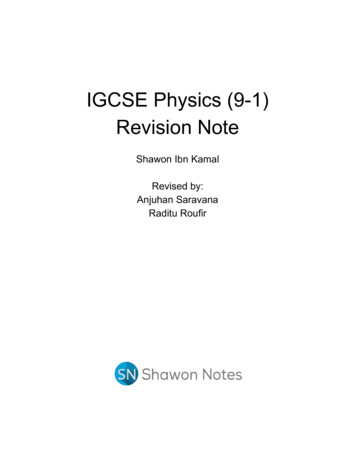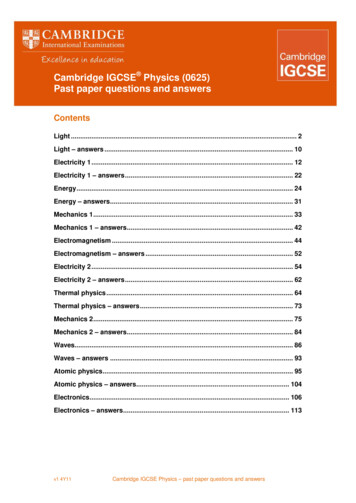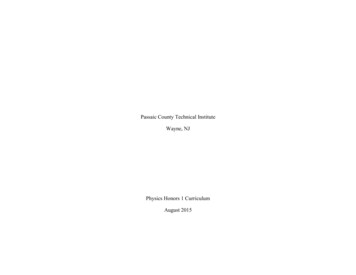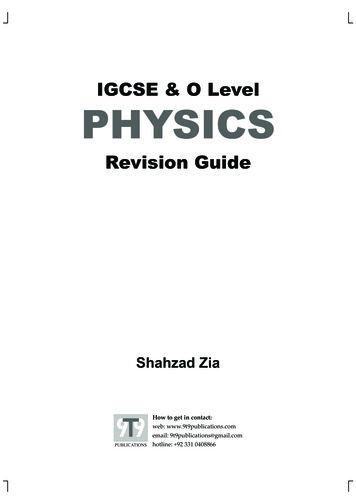
Transcription
IGCSE & O LevelPHYSICSRevision GuideShahzad ZiaHow to get in contact:web: www.9t9publications.comPUBLICATIONSemail: 9t9publications@gmail.comhotline: 92 331 0408866
ContentsSectionUnitPageI. General Physics1.Physical Quantities, Units and MeasurementII. Newtonian Mechanics2.Kinematics153.Dynamics274.Mass, Weight and Densities375.Turning Effect of Forces436.Deformation497.Pressure538.Energy Sources & Transfer of Energy619.Transfer of Thermal Energy71III. Energy and Thermal PhysicsIV.WavesV. Electricity and MagnetismVI. Atomic Physics510. Temperature7711. Thermal Properties of Matter8512. Kinetic Model of Matter9513. General Wave Properties10114a. Light: Reflection10714b. Light: Refraction11314c. Light: Lenses11915. Electromagnetic Spectrum12716. Sound13317. Magnetism13918. Static Electricity15119. Current Electricity16120. DC Circuits17321. Practical Electricity17722. Electromagnetism18723. Electromagnetic Induction19324. Introductory Electronics20325. Electronic Systems21526. Radioactivity22127. The Nuclear Atom233Appendix IFull Syllabus Formulae239Appendix IIVariations in O Level & IGCSE Syllabus244Index245Revision Planner2474
1Physical Quantities, Unitsand MeasurementAfter reading this unit, you will be able to(a)(b)(c)(d)state that a physical quantity needs magnitude along with a unitstate that there are two types of physical quantities, base and derived quantities.recognise and use of System International (SI) units and their prefixes.differentiate between the terms scalar and vector.(e) list the vectors and scalars from distance, displacement, length, speed, velocity, time,acceleration, mass and force.(f) determine the resultant of two vectors by a graphical method.(g) describe how to measure a variety of lengths with appropriate accuracy using tapes, rules,micrometers and callipers.(h) describe how to measure a variety of time intervals using clocks and stopwatches.Key Definitionsphysical quantityany measurable characteristic of an objectmagnitudea numerical value that represents a measurementunita part of a physical quantity that is used as a standard whilemeasurementprefixa term used for multiple or sub-multiple of 10scalara physical quantity that has magnitude but no directionvectora physical quantity that has both magnitude and directionparallax erroran error in a measurement that occurs because of wrongpositioning of eyeleast countminimum value of a measurement that can be observed accuratelywith the help of a measuring deviceoscillationof a clock pendulum is its journey from one extreme position tothe other and then back to the first.frequencynumber of complete oscillations made in 1 speriodtime taken for 1 complete oscillationUnit 1 Physical Quantities, Units and Measurement5
1.1 Physical Quantities and Units-Physics is the study of matter and energy and the interrelationship between them.Major branches of physics are general physics, thermal physics, waves, electricity, magnetism, andatomic physics.--Any measurable characteristic of an object is called physical quantity. Some of the commonly usedphysical quantities are distance, mass, time, force, speed, volume, temperature, electric current andpressure.A physical quantity is expressed using-magnitude which is a number along withan appropriate unit.Physical quantities are of two types:numberuniti.-Base quantities are the physical quantitiesfig. 1.1in terms of which other physical quantitiescan be described. Distance, mass and time are examples of base quantities.ii. Derived quantities are the physical quantities which can be described in terms of basequantities. Velocity, acceleration and force are examples of derived quantities.A unit is a part of a physical quantity that is used as a standard while its measurement.Units are of two types:i.Base units are the units for base quantities, e.g. meter (m), kilogram (kg), second (s) etc.ii. Derived units are the units for derived quantities, e.g. meter per second (m/s), newton (N),watt (W) etc.SI Units-A set of base and derived units is called system of units. British Engineering System and SystemInternational units (SI units) are two examples of system of units.System International units (SI units) have been adopted internationally for the efficient measurementof physical quantities. The table. 1.2 shows a list of seven base quantities and their correspondingSI TimesecondsTemperatureKelvinKElectric CurrentAmpereAIntensity of LightCandelaCdAmount of Substancemolemoltable 1.2Derivation of Derived Units- Derived units are expressed in terms of base units by means of mathematical symbols of multiplicationand division.6Unit 1 Physical Quantities, Units and Measurement
2KinematicsAfter reading this unit, you will be able to(a) state what is meant by rest and motion, and discuss different types of motion.(b) state how displacement is different from distance.(c) state what is meant by speed and velocity.(d) state what is meant by acceleration and calculate the value of an acceleration using changein velocity/time taken.(e) discuss uniform and non-uniform acceleration.(f) plot and interpret speed-time and distance-time graphs.(g) calculate the area under a speed-time graph to determine the distance travelled for motionwith uniform speed or uniform acceleration.(h) state that the acceleration of free-fall for a body near to the Earth is constant and isapproximately 10 m/s2.(i) describe the motion of bodies falling with and without air resistance (including referenceto terminal velocity).Key Definitionsdistancelength of the path between two pointsdisplacementshortest distance between two pointsspeedrate at which distance changesvelocityrate at which displacement changesaccelerationrate at which velocity changesgradienta line s rise divided by its runacceleration of free fallacceleration experienced by an object when it falls freely underthe influence of gravityterminal speedmaximum speed gained by an object while moving through afluid (liquid or gas)Mechanics- Mechanics is the branch of physics that deals with the study of objects in motion. The subject ofmechanics is divided into two sub-branches: kinematics and dynamics.-Kinematics deals with the motion of objects without discussing the agents causing motion while indynamics the motion of objects is studied with reference to the agents causing motion.Unit 2 Kinematics15
2.1 Speed, Velocity and AccelerationRest and Motion-If an object does not change its position with respect to its surroundings, then it is said to be at rest,but if an object changes its position with respect to its surroundings, then it is said to be in motion.Rest and motion are relative terms. This means that thestate of rest or motion of an object always needs anotherobject with respect to which its position is compared.For example, when a bus moves on a road, the bus aswell as the passengers sitting inside change theirpositions with respect to a person standing on the roadside. However, the passengers sitting in the bus do notchange their positions with respect to each other. Sothey are at rest with respect to each other.-Motion of an object can be one of the following types:i.translatory motionii. rotatory motioniii. vibratory motioniv. random motionfig. 2.1Translatory Motion- The type of motion in which every particle of a moving object displaces by the same amount is calledtranslatory motion.- Translatory motion of an object can also be either ofthe following two types:i.Linear Motion: If an object moves along astraight line, then its motion is called linearmotion. For example, the motion of a freelyfalling object, the motion of a car on a straightroad, the motion of an aeroplane before takingii.off etc.Circular Motion: If an object moves along acurved path, then its motion is called circularmotion. For example, the motion of planetsaround the sun, the motion of a car at a roadfig. 2.2axis of rotationcorner etc.Rotatory Motion- If an object moves around a fixed axis or a point,then its motion is called rotatory motion. For example,the motion of the blades of a ceiling fan, the rotation ofearth about its own axis, the rotation of wheel of astationary cycle etc.16Unit 2 Kinematicsfig. 2.3
3DynamicsAfter reading this unit, you will be able to(a) state different types of forces and their effects on the motion of objects.(b) describe the effect of balanced and unbalanced forces on a body.(c) recall and use the equation force mass acceleration.(d) state and explain Newton s laws of motion.(e) explain that friction is a force that impedes motion and produces heat.(f) discuss the effect of friction on the motion of a vehicle in the context of tyre surface, roadconditions, braking force, braking distance, thinking distance and stopping distance.(g) describe qualitatively motion in a circular path due to a constant perpendicular force,including electrostatic forces on an electron in an atom and gravitational forces on asatellite.Key Definitionsforcean interaction that tends to change the state of rest or motion ofan object in a straight linenewton (N)SI unit of force; a force of 1 N produces an acceleration of1 m s-2 in an object of mass 1 kgcontact forcea type of force that requires a physical contact for its actionfield forcea type of force that does not require a physical contact for itsactionbalanced forcesforces when added cause no accelerationunbalanced forcesforces when added cause accelerationfrictiona type of contact force that resists the motion of one object overthe surface of another objectstopping distanceminimum distance a vehicle requires to stop completelythinking distancedistance travelled by a vehicle during the driver's reaction timebreaking distancedistance travelled by a vehicle once the brakes are applied untilit stopscentripetal forcea force that compels an object to move along a curved pathUnit 3 Dynamics27
3.1 Balanced and Unbalanced ForcesForce (F)-Dynamics is the branch of mechanics that deals with the motion of objects under the action of forces.A force is a push or pull that an object exerts on another. In a broader sense, a force is an interaction-that tends to change the state of rest or motion of an object in a straight line.Force is a vector quantity and its SI unit is newton (N).One newton (N) is the amount of force that produces an acceleration of1 m s-2 in an object of mass 1 kg.--iii. a moving object loses speediv. a moving object changes its direction of motionBesides change in motion, a force can also change the size and shape ofan object.Force is usually measured with the help of spring balance or newton-meter.N-Following are the effects of forces on the motion of objectsi.a stationary object can start movingii. a moving object gains speed6050403020010pullfig. 3.1Types of Forces- Variety of forces exist aound us which can be put into two major categories:i.Contact Forcesii. Field Forces-A contact force is a force that requires a physical contact for its action.Some common types of contact forces are:Name of Contact ForcefrictionExampletype of contact force that resists the motion of one object overthe surface of another objecttensionthe pull at both ends of a stretched string or springnormal forcethe force exerted on an object perpendcularly by a flat surfaceviscous forcethe opposing force found in fluids like water and oilforward thrustthe force that causes a vehicle to move forwardspring forcethe force exerted by a compressed or stretched spring uponany object that is attached to ittable 3.228Unit 3 Dynamics
4Mass, Weight and DensitiesAfter reading this unit, you will be able to(a) state that mass is a measure of the amount of substance in a body.(b) state that the mass of a body resists change from its state of rest or motion.(c) state that a gravitational field is a region in which a mass experiences a force due togravitational attraction.(d) state that weight of an object is the force of gravity on it by the Earth.(e)(f)(g)(h)use the equation weight mass gravitational field strength.describe how to measure mass and weight by using appropriate balances.define density and recall and use the formula density mass/volume.state why do some objects float while others sink.(i) describe how to determine the density of a liquid, of a regularly shaped solid and of anirregularly shaped solid which sinks in water (volume by displacement).Key Definitionsmassmeasure of the amount of matter in an object; the characteristicof an object that resists change from its state of rest or motioninertiaa characteristic of mass that resists any change in its state of restor of uniform motiongravitya force of attraction that exists naturally between any two materialobjects; also known as gravitational forceweightthe gravitational force acting on an object by the Earthgravitational fielda region of space in which a mass experiences a force due togravitational attractiongravitational field strengthgravitational force acting per unit mass on an object; near thesurface of the Earth, its numerical value is 9.8 N/kg (10 N/kg)densitymass per unit volume of a substance4.1 Mass & WeightMass (m)-The mass (m) of an object is a measure of the amount of matter contained in it.The amount of matter an object has, depends upon the number and composition of atoms andmolecules that make up the object.Unit 4 Mass, Weight and Densities37
-Mass is, in fact, that characteristic of an object which determines the magnitude of acceleration-produced when a certain force acts upon it.It is a characteristic of an object that cannot be changed by its location, shape and speed.It is a scalar quantity.Instruments like pan balance, beam balance or electronic balance are used for measuring mass ofobjects.beam balanceelectronic balancepan balance-fig. 4.1The SI unit of mass is kilogram (kg). Other commonly used units of mass are tonne, gram andmilligram.1 tonne 1000 kg1 kg 1000 g1 g 1000 mgInertia- Owing to their mass, all material objects possess a characteristic due to which they resist any changein their state of rest or uniform motion. This characteristic is called inertia.- The inertia shown by an object is directly related to its mass. More the mass of an object, greater theinertia it has, and thus it is harder to make the object start moving, slow down, move faster or changedirection.- Some everyday examples of this feature of mass are:i. It is difficult to push a loaded trolley as compared with an empty trolley.ii. When a card with a heavy coin on top placed on a glass is flicked sharply, the coin drops downwhile the card flies off.iii. Passengers lurch forward when a vehicle stops suddenly. Similarly, they fall backward whena vehicle starts or gears up suddenly.iv. When a car makes a sharp turn, the passengers move to the inner side of the turn.v. In order to avoid an elephant, one is advised to move in a zig-zag manner.coincoinfig. 4.238Unit 4 Mass, Weight and Densities
5Turning Effect of ForcesAfter reading this unit, you will be able to(a) describe the moment of a force in terms of its turning effect.(b) recall and use the formulamoment force perpendicular distance from the pivot and the principle of moments(c) state the principle of moments for a body in equilibrium.(d) define centre of mass and describe how to determine the position of the centre of massof a plane lamina.(e) state what is meant by stability and describe qualitatively the effect of the position of thecentre of mass on the stability of simple objects.Key Definitionsmoment of forcea measure of the turning effect of force about pivot; is the productof force and moment armmoment armthe perpendicular distance between the line of action of force andpivotpivota point or a line about which an object rotatesprinciple of momentssum of clockwise moments about a pivot is equal to the sum ofanticlockwise moments about the same pivotcentre of massa point on or inside an object through which its whole weightappears to actequilibriuma steady state of an object when no resultant force and no resultantmoment act on itstabilitya measure of how difficult it is to move an object from a positionof equilibrium with respect to gravity5.1 MomentsMoment of Force (T)- The turning effect of a force about a fixed point or a fixed axis is measured by a quantity calledmoment of force or torque.- The fixed point or the fixed axis about which an object rotates is called pivot whereas the perpendiculardistance between line of action of force and the pivot is called moment arm.Note that moment of force is sometimes simply referred to as moment only.Unit 5 Turning Effect of Forces43
-The turning effect produced in a body depends upontwo factors:i. magnitude of the applied forceii. perpendicular distance of the applied force fromthe pivot (moment arm)-momentforcepivotGreater is the magnitude of force applied on an object,greater will be the turning effect and vice versa.Similarly, greater is the perpendicular distance of themoment armapplied force from the pivot, greater will be the turningeffect and vice versa.Based upon, the two factors mentioned above, momentof force is defined as follows:-fig. 5.1Moment of force is the product of the applied force (F) and the perpendiculardistance (d) between the line of action of force and pivot.i.e.,T F dThe SI unit of the moment of force is the newton metre (Nm).Moment of force is a vector quantity. The direction of moment of force can be either clockwise oranticlockwise.If there are more than one forces acting on an object, then there are also more than one momentsabout a given pivot. In this case, the resultant moment is calculated by the subtracting the sum ofall the moments in clockwise direction from the sum of all the moments in anticlockwise direction.-Tnet Tanticlockwise - TclockwisePrinciple of Moments- The principle of moments states thatWhen a body is in equilibrium, the sum ofclockwise moments about a pivot is equal tothe sum of anticlockwise moments about thesame pivot.d1F1Mathematically,d2F1 d1 F2 d2F2fig. 5.2sum of clockwise moments sum of anticlockwise moments5.2 Center of Mass-Centre of mass or centre of gravity of an object is the point through which its whole weight appears-to act and if the object is supported at this point then it stands still without rotation.Centre of mass can exist inside or outside of the object depending upon its shape and distributionof its mass.44Unit 5 Turning Effect of Forces
Unit 2 Kinematics 15 2 Kinematics Key Definitions terminal speed maximum speed gained by an object while moving through a fluid (liquid or gas) acceleration of free fall acceleration experienced by an object when it falls freely under the influence of gravity gradient a line's rise divided by its run acceleration rate at which velocity changes velocity rate at which displacement changes

